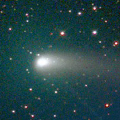
|
Now it is bright as 9.3 mag (Nov. 6, Katsumi Yoshimoto). It stays 9 mag until January, and it is observable in good condition.
Date(TT) R.A. (2000) Decl. Delta r Elong. m1 Best Time(A, h)
Nov. 6 7 36.57 26 32.5 0.419 1.212 111 9.2 4:36 ( 0, 81)
Nov. 13 8 0.82 26 44.2 0.418 1.218 113 9.0 4:32 ( 0, 82)
|
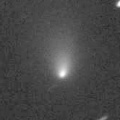
|
Now it is 11.0 mag (Oct. 29, Michael Jager). It will approach to Earth down to 0.2 a.u. in December, and it is expected to brighten up to 4 mag. In the Northern Hemisphere, it stays observable in good condition for a long time until December while the comet is brightening gradually. In the Southern Hemisphere, it is not observable until mid December.
Date(TT) R.A. (2000) Decl. Delta r Elong. m1 Best Time(A, h)
Nov. 6 11 58.24 34 29.3 1.401 1.314 63 10.4 4:59 (253, 42)
Nov. 13 12 10.29 33 54.7 1.163 1.205 67 9.6 5:05 (255, 46)
|
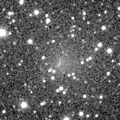
|
Now it is bright as 10.1 mag (Nov. 7, Chris Wyatt). It is observable at 10 mag in good condition from October to December. In the Northern Hemisphere, it locates somewhat low at the high light.
Date(TT) R.A. (2000) Decl. Delta r Elong. m1 Best Time(A, h)
Nov. 6 21 3.30 -31 30.5 1.158 1.467 85 9.8 18:27 ( 6, 23)
Nov. 13 21 29.15 -30 48.4 1.226 1.498 84 9.9 18:23 ( 5, 24)
|
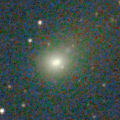
|
Now it is 9.7 mag (Nov. 5, Marek Biely). It stays bright as 10 mag until spring for a long time. In the Northern Hemisphere, it stays observable in good condition for a long time. In the Southern Hemisphere, it locates extremely low until November.
Date(TT) R.A. (2000) Decl. Delta r Elong. m1 Best Time(A, h)
Nov. 6 7 47.14 40 3.3 3.127 3.603 110 10.3 4:47 (180, 85)
Nov. 13 7 46.82 39 24.4 3.026 3.593 117 10.2 4:19 (180, 86)
|
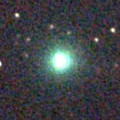
|
It brightened very rapidly, and brightened up to 8.9 mag (Sept. 11, Chris Wyatt). Now it is fading. But it is bright as 11 mag still now (Nov. 1, Giuseppe Pappa). In the Southern Hemisphere, it stays observable after this while the comet will be fading. But it stays locating low. It is not observable after this in the Northern Hemisphere.
Date(TT) R.A. (2000) Decl. Delta r Elong. m1 Best Time(A, h)
Nov. 6 12 48.09 -42 6.5 2.134 1.456 36 10.5 4:59 (314,-11)
Nov. 13 13 14.21 -44 38.4 2.204 1.525 36 10.9 5:05 (317,-12)
|
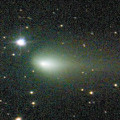
|
Now it is bright as 10.9 mag (Oct. 17, Osamu Miyazaki). It stays observable at 10-11 mag in excellent condition from summer to autumn.
Date(TT) R.A. (2000) Decl. Delta r Elong. m1 Best Time(A, h)
Nov. 6 6 52.58 10 49.1 1.003 1.724 119 10.5 3:52 ( 0, 66)
Nov. 13 6 56.28 9 49.0 0.980 1.749 125 10.6 3:28 ( 0, 65)
|
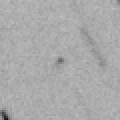
|
Now it is 11.6 mag (Nov. 2, Chris Wyatt). It will brighten rapidly up to 9 mag in winter. It will be observable in good condition. In the Southern Hemisphere, it is observable in excellent condition. It will be getting higher rapidly after this also in the Northren Hemisphere.
Date(TT) R.A. (2000) Decl. Delta r Elong. m1 Best Time(A, h)
Nov. 6 23 4.98 -50 7.1 1.190 1.656 98 11.4 20:02 ( 0, 5)
Nov. 13 23 8.36 -47 9.4 1.185 1.610 95 11.0 19:38 ( 0, 8)
|
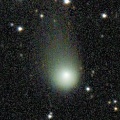
|
Now it is bright as 11.4 mag (Oct. 29, Osamu Miyazaki). It is expected to be observable at 5-6 mag for a long time from 2022 to 2023. In the Northern Hemisphere, it is not observable at the high light from 2022 autumn to 2023 summer. In the Southern Hemisphere, it is not observable until February. But it will be observable in good condition at the high light.
Date(TT) R.A. (2000) Decl. Delta r Elong. m1 Best Time(A, h)
Nov. 6 17 16.09 19 51.9 5.443 4.891 51 11.6 18:27 ( 92, 33)
Nov. 13 17 20.52 18 46.8 5.431 4.829 48 11.5 18:23 ( 94, 28)
|
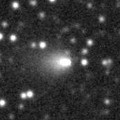
|
Major outburst occured on Oct. 17. Now it is very bright as 11.5 mag (Oct. 22, Marco Goiato). It stays observable in the evening sky for a while.
Date(TT) R.A. (2000) Decl. Delta r Elong. m1 Best Time(A, h)
Nov. 6 19 1.69 -20 38.7 1.978 1.730 60 12.0 18:27 ( 38, 24)
Nov. 13 19 21.57 -20 12.9 2.034 1.738 58 12.1 18:23 ( 39, 24)
|
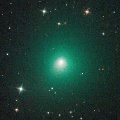
|
It brightened up to 9.5 mag in early summer (June 27, Marco Goiato). Now it is fading. It has already faded down to 13.4 mag (Oct. 25, Chris Wyatt). It will be unobservable soon in the Northern Hemisphere, or in November in the Southern Hemisphere.
Date(TT) R.A. (2000) Decl. Delta r Elong. m1 Best Time(A, h)
Nov. 6 17 35.85 -30 21.4 3.128 2.478 41 12.3 18:27 ( 47, 5)
Nov. 13 17 51.62 -31 8.4 3.224 2.523 38 12.5 18:23 ( 48, 3)
|
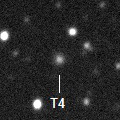
|
Now it is 13.8 mag (Oct. 9, Chris Wyatt). It is expected to brighten up to 11.5 mag in 2022. In the Southern Hemisphere, it stas observable in good condition for a long time, although it became extremely low temporarily from August to September. It is getting observable also in the Northern Hemisphere.
Date(TT) R.A. (2000) Decl. Delta r Elong. m1 Best Time(A, h)
Nov. 6 11 19.69 -26 22.8 5.197 4.601 48 13.0 4:59 (315, 12)
Nov. 13 11 26.23 -26 51.2 5.112 4.579 52 12.9 5:05 (321, 16)
|
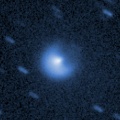
|
Major outburst occured on Sept. 25, and it brightened up to 10.0 mag (Oct. 1, Toshihiko Ikemura, Hirohisa Sato). Now it is fading. But it is bright as 11.2 mag still now (Nov. 5, Osamu Miyazaki).
Date(TT) R.A. (2000) Decl. Delta r Elong. m1 Best Time(A, h)
Nov. 6 4 49.99 32 16.3 5.071 5.928 147 13.3 1:50 ( 0, 87)
Nov. 13 4 46.81 32 14.5 5.023 5.930 154 13.3 1:20 ( 0, 87)
|
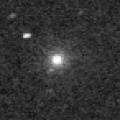
|
It was observed at 9-10 mag from late July to early August. Now it is not observable. It will appear in the morning sky in December, but it will be fainter than 15 mag at that time.
Date(TT) R.A. (2000) Decl. Delta r Elong. m1 Best Time(A, h)
Nov. 6 14 17.91 -10 5.1 2.651 1.677 8 13.4 4:59 (276, -9)
Nov. 13 14 32.35 -12 6.1 2.733 1.773 11 13.7 5:05 (280, -7)
|
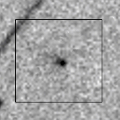
|
Now it is not observable. In the Southern Hemisphere, it will appear in the morning sky at 11 mag in late January, then it stays observable at 11 mag until June. In the Northern Hemisphere, it will appear in the morning sky in December, but it stays locating extremely low for a long time.
Date(TT) R.A. (2000) Decl. Delta r Elong. m1 Best Time(A, h)
Nov. 6 14 24.36 -10 57.9 2.997 2.017 6 14.1 4:59 (276,-11)
Nov. 13 14 40.49 -12 17.4 2.946 1.977 9 13.9 5:05 (279, -9)
|

|
It brightened up to 12.3 mag from spring to summer (June 15, Marco Goiato). Now it is fading. It has already faded down to 13.8 mag (Sept. 8, Chris Wyatt). Now it is not observable. It will be observable again at 14 mag in November in the Northern Hemisphere, or in January in the Southern Hemisphere.
Date(TT) R.A. (2000) Decl. Delta r Elong. m1 Best Time(A, h)
Nov. 6 14 11.04 -1 15.1 4.779 3.840 16 13.9 4:59 (269, -3)
Nov. 13 14 14.17 -0 49.2 4.769 3.872 22 14.0 5:05 (273, 3)
|
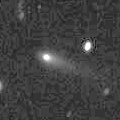
|
Now it is 13.7 mag (Oct. 25, Chris Wyatt). It stays 14 mag unil December, and it is observable in excellent condition.
Date(TT) R.A. (2000) Decl. Delta r Elong. m1 Best Time(A, h)
Nov. 6 0 26.85 -3 42.0 0.805 1.693 140 14.0 21:24 ( 0, 51)
Nov. 13 0 31.51 -3 34.5 0.841 1.692 134 14.0 21:01 ( 0, 52)
|
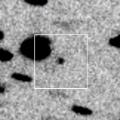
|
It will brighten up to 12 mag from winter to spring. In the Northern Hemisphere, it is appearing in the morning sky. In the Southern Hemisphere, it is not observable until January.
Date(TT) R.A. (2000) Decl. Delta r Elong. m1 Best Time(A, h)
Nov. 6 13 13.92 -0 41.4 2.742 1.912 26 14.4 4:59 (277, 9)
Nov. 13 13 30.16 -2 27.9 2.674 1.876 29 14.2 5:05 (281, 11)
|
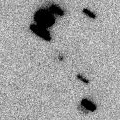
|
Now it is 17.1 mag (Nov. 3, Toshihiko Ikemura, Hirohisa Sato). It will brightens rapidly. And it is expected to be observable at 12-13 mag in good condition from December to February. However, it is much fainter than this ephemeris recently.
Date(TT) R.A. (2000) Decl. Delta r Elong. m1 Best Time(A, h)
Nov. 6 21 50.23 -9 59.2 0.767 1.381 102 14.7 18:48 ( 0, 45)
Nov. 13 21 58.59 -10 15.0 0.765 1.329 97 14.4 18:29 ( 0, 45)
|

|
Now it is 16.0 mag (Aug. 16, iTelescope Observatory, Siding Spring). It is expected to brighten up to 13 mag in 2022. In the Southern Hemisphere, it stays observable in good condition for a long time, although it became extremely low temporarily from September to October. In the Northern Hemisphere, it becomes observable temporarily in the extremely low sky in December. But it becomes unobservable again soon.
Date(TT) R.A. (2000) Decl. Delta r Elong. m1 Best Time(A, h)
Nov. 6 12 38.55 -36 12.1 4.565 3.790 34 15.1 4:59 (310, -6)
Nov. 13 12 41.54 -37 52.9 4.477 3.754 38 15.0 5:05 (316, -3)
|
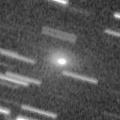
|
Now it is 15.7 mag (Nov. 4, Toshihiko Ikemura, Hirohisa Sato). It stays 15 mag until November. It will be observable in excellent condition in the Northern Hemisphere. It locates somewhat low in the Southern Hemisphere.
Date(TT) R.A. (2000) Decl. Delta r Elong. m1 Best Time(A, h)
Nov. 6 7 14.09 30 38.8 1.062 1.753 117 15.2 4:14 ( 0, 86)
Nov. 13 7 20.38 31 54.9 1.033 1.776 122 15.3 3:53 ( 0, 87)
|

|
Now it is 14.5 mag (Nov. 4, Toshihiko Ikemura, Hirohisa Sato). It will be fading after this. In the Southern Hemisphere, it stays observable in good condition for a long time. It locates low in the Northern Hemisphere.
Date(TT) R.A. (2000) Decl. Delta r Elong. m1 Best Time(A, h)
Nov. 6 22 23.60 -24 20.8 4.359 4.711 104 15.2 19:21 ( 0, 31)
Nov. 13 22 23.46 -23 12.6 4.487 4.733 98 15.3 18:53 ( 0, 32)
|
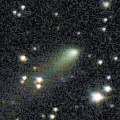
|
Now it is 14.2 mag (Oct. 21, Giuseppe Pappa). It will be fading after this. In the Northern Hemisphere, it stays observable in good condition for a long time, although it becomes extremely low temporarily in November. In the Southern Hemisphere, it is not observable until late January.
Date(TT) R.A. (2000) Decl. Delta r Elong. m1 Best Time(A, h)
Nov. 6 16 6.94 17 14.3 3.027 2.340 38 15.3 18:27 ( 99, 17)
Nov. 13 16 7.79 17 0.5 3.063 2.356 37 15.4 18:23 (102, 13)
|

|
Now it is 15.9 mag (Oct. 8, Thomas Lehmann). It stays at 14-15 mag for a long time from 2021 to 2022. It is not observable from November to January.
Date(TT) R.A. (2000) Decl. Delta r Elong. m1 Best Time(A, h)
Nov. 6 16 33.52 -22 37.6 5.859 4.993 26 15.3 18:27 ( 62, -1)
Nov. 13 16 36.78 -23 26.3 5.909 4.994 20 15.3 18:23 ( 65, -5)
|
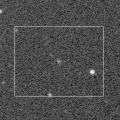
|
Now it is 15.9 mag (Oct. 24, Taras Prystavski). It will brighten up to 12.5 mag in 2022 summer. In the Southern Hemisphere, it stays observable in excellent condition for a long time. In the Northern Hemisphere, it is not observable until August in 2022.
Date(TT) R.A. (2000) Decl. Delta r Elong. m1 Best Time(A, h)
Nov. 6 0 16.18 -76 8.0 4.198 4.233 85 15.4 21:10 ( 0,-21)
Nov. 13 23 43.21 -75 18.7 4.220 4.188 81 15.3 20:11 ( 0,-20)
|

|
Now it is 15.8 mag (Oct. 4, Thomas Lehmann). Now it is not observable. It will appear in the morning sky at 15 mag in January. Then it will brighten up to 13 mag in 2022 summer.
Date(TT) R.A. (2000) Decl. Delta r Elong. m1 Best Time(A, h)
Nov. 6 15 15.53 -17 25.8 4.243 3.263 7 15.4 18:27 ( 77,-13)
Nov. 13 15 25.92 -18 14.1 4.239 3.251 3 15.4 18:23 ( 78,-16)
|

|
Now it is 15.3 mag (Oct. 25, Chris Wyatt). It will be fading slowly after this. It will be unobservable in December.
Date(TT) R.A. (2000) Decl. Delta r Elong. m1 Best Time(A, h)
Nov. 6 19 42.73 -33 7.6 3.388 3.166 68 15.4 18:27 ( 23, 18)
Nov. 13 19 52.29 -32 40.1 3.490 3.181 63 15.5 18:23 ( 26, 17)
|
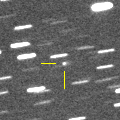
|
It brightened rapidly. Now it is 15.6 mag (Nov. 4, Toshihiko Ikemura, Hirohisa Sato). It is observable at 15 mag in excellent condition in winter.
Date(TT) R.A. (2000) Decl. Delta r Elong. m1 Best Time(A, h)
Nov. 6 8 27.25 20 52.4 2.093 2.458 99 15.5 4:59 (335, 75)
Nov. 13 8 32.67 20 6.4 2.011 2.461 105 15.4 5:05 ( 0, 75)
|

|
Now it is 15 mag (Oct. 31, Giuseppe Pappa). It was expected to brighten up to 13 mag from spring to summer. But actually, it is fainter than originally expected. It will be fading slowly after this. In the Southern Hemisphere, it stays observable in good condition for a long time. In the Northern Hemisphere, it is not observable until July in 2022.
Date(TT) R.A. (2000) Decl. Delta r Elong. m1 Best Time(A, h)
Nov. 6 21 49.18 -70 40.1 3.841 3.801 80 15.4 18:48 ( 0,-15)
Nov. 13 21 59.70 -68 40.4 3.910 3.821 77 15.5 18:31 ( 0,-13)
|
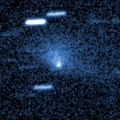
|
It brightened up to 10.1 mag in spring (Apr. 10, Marco Goiato). Now it is fading. It has already faded down to 16.0 mag (Nov. 2, Toshihiko Ikemura, Hirohisa Sato). It stays observable in good condition for a long time after this while the comet will fading.
Date(TT) R.A. (2000) Decl. Delta r Elong. m1 Best Time(A, h)
Nov. 6 4 36.87 5 31.8 1.611 2.521 150 15.5 1:37 ( 0, 61)
Nov. 13 4 29.53 5 21.7 1.622 2.563 157 15.6 1:03 ( 0, 60)
|
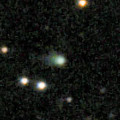
|
Now it is 15.3 mag (Oct. 29, Toshihiko Ikemura, Hirohisa Sato). It is expected to brighten up to 11 mag in 2023. In the Northern Hemisphere, it stays observable in good condition for a long time, although it becomes low temporarily in November. It is not observable in the Southern Hemisphere.
Date(TT) R.A. (2000) Decl. Delta r Elong. m1 Best Time(A, h)
Nov. 6 16 14.02 33 8.7 6.222 5.689 53 15.6 18:27 (113, 26)
Nov. 13 16 16.56 32 31.8 6.190 5.646 52 15.6 18:23 (115, 22)
|
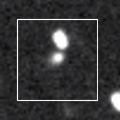
|
Now it is 15.7 mag (Oct. 25, D. Buczynski). It is expected to brighten up to 10 mag in 2023. In the Northern Hemisphere, it stays observable in good condition until 2023 autumn, although it became extremely low temporarily in September. In the Southern Hemipshere, it stays unobservable until 2023 summer.
Date(TT) R.A. (2000) Decl. Delta r Elong. m1 Best Time(A, h)
Nov. 6 12 47.17 34 33.1 6.412 5.940 57 15.8 4:59 (248, 32)
Nov. 13 12 50.67 34 58.5 6.274 5.885 62 15.7 5:05 (250, 38)
|
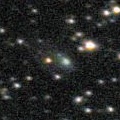
|
Now it is 15.2 mag (Oct. 29, Toshihiko Ikemura, Hirohisa Sato). It is expected to brighten up to 11 mag from spring to summer in 2022. In the Southen Hemisphere, it locates somewhat low in 2021, but it will be observable in good condition at the high light for a long time. In the Northern Hemisphere, it is observable in good condition in 2021, but it will not be observable at the high light.
Date(TT) R.A. (2000) Decl. Delta r Elong. m1 Best Time(A, h)
Nov. 6 18 39.41 4 53.8 3.521 3.175 61 15.8 18:27 ( 62, 40)
Nov. 13 18 42.28 3 2.4 3.559 3.112 55 15.7 18:23 ( 65, 36)
|
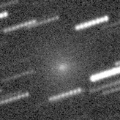
|
Now it is 14.7 mag (Oct. 14, Sandor Szabo). It stays observable in good condition for a long time. It will be fading rapidly after this, and it will be fainter than 18 mag in January.
Date(TT) R.A. (2000) Decl. Delta r Elong. m1 Best Time(A, h)
Nov. 6 10 12.51 1 45.7 1.491 1.471 69 15.7 4:59 (310, 45)
Nov. 13 10 25.74 -0 21.0 1.483 1.515 72 16.0 5:05 (317, 46)
|
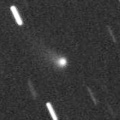
|
Now it is 15.9 mag (Sept. 24, D. Buczynski). In the Northern Hemisphere, it stays observable at 15-16 mag for a long time until early 2022, although it became extremely low temporarily from September to October. In the Southern Hemisphere, it is not observable until December.
Date(TT) R.A. (2000) Decl. Delta r Elong. m1 Best Time(A, h)
Nov. 6 13 11.16 21 49.3 3.737 3.102 44 15.7 4:59 (258, 22)
Nov. 13 13 13.88 20 34.3 3.691 3.120 48 15.7 5:05 (263, 27)
|
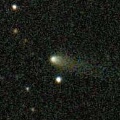
|
It brightened up to 14.5 mag in autumn (Oct. 1, Ken-ichi Kadota). Now it is fading. It has already faded down to 16.2 mag (Nov. 4, Toshihiko Ikemura, Hirohisa Sato). It will be fading rapidly after this. It will be fainter than 18 mag in February.
Date(TT) R.A. (2000) Decl. Delta r Elong. m1 Best Time(A, h)
Nov. 6 23 9.25 -16 52.5 1.693 2.326 117 16.0 20:07 ( 0, 38)
Nov. 13 23 13.78 -16 24.8 1.776 2.335 111 16.1 19:44 ( 0, 39)
|
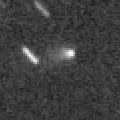
|
Now it is 17.6 mag (Nov. 5, Toshihiko Ikemura, Hirohisa Sato). It is expected to brighten up to 15.5 mag in winter. In the Northern Hemisphere, it stays observable in good condition for a long time. It is not observable at all in the Southern Hemisphere. It is fainter than this ephemeris recently.
Date(TT) R.A. (2000) Decl. Delta r Elong. m1 Best Time(A, h)
Nov. 6 15 46.79 62 12.5 3.111 3.080 79 16.1 18:27 (147, 32)
Nov. 13 15 51.03 62 14.1 3.065 3.061 80 16.0 18:23 (147, 30)
|
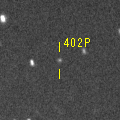
|
First return of a new periodic comet observed at 16 mag from 2003 to 2004. Now it is 16.6 mag (Oct. 29, Toshihiko Ikemura, Hirohisa Sato). It will brighten up to 16 mag in winter, and it will be observable in excellent condition.
Date(TT) R.A. (2000) Decl. Delta r Elong. m1 Best Time(A, h)
Nov. 6 6 41.26 0 43.2 3.358 3.944 119 16.1 3:41 ( 0, 56)
Nov. 13 6 40.56 0 42.8 3.277 3.942 126 16.0 3:13 ( 0, 56)
|
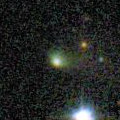
|
Now it is 15.4 mag (Oct. 20, Ken-ichi Kadota). It continues brightening even after the perihelion passage. It may stay 15-16 mag for a while.
Date(TT) R.A. (2000) Decl. Delta r Elong. m1 Best Time(A, h)
Nov. 6 0 54.75 -14 48.7 2.241 3.059 139 16.1 21:51 ( 0, 40)
Nov. 13 0 53.92 -14 36.2 2.337 3.097 132 16.3 21:23 ( 0, 41)
|
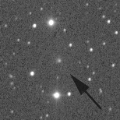
|
It brightened up to 14.2 mag in early summer (June 10, Thomas Lehmann). Now it is fading. In the Northern Hemisphere, it is appearing in the morning sky. In the Southern Hemisphere, it will never be observable again.
Date(TT) R.A. (2000) Decl. Delta r Elong. m1 Best Time(A, h)
Nov. 6 13 26.22 29 24.0 2.927 2.397 49 16.1 4:59 (249, 23)
Nov. 13 13 42.78 30 38.0 2.907 2.444 53 16.2 5:05 (250, 26)
|
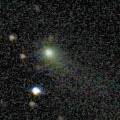
|
Now it is 16.4 mag (Oct. 22, ATLAS-MLO, Mauna Loa). It stays observable in good condition for a long time. But it will be fading after this.
Date(TT) R.A. (2000) Decl. Delta r Elong. m1 Best Time(A, h)
Nov. 6 22 58.37 2 52.5 1.531 2.232 122 16.1 19:56 ( 0, 58)
Nov. 13 23 2.15 3 23.8 1.613 2.244 117 16.3 19:32 ( 0, 59)
|
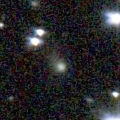
|
Now it is 16.2 mag (Oct. 29, Toshihiko Ikemura, Hirohisa Sato). It is expected to brighten up to 11 mag in 2023. In the Northern Hemisphere, it is observable in good condition in 2021. But it is observable only until November in 2022. In the Southern Hemisphere, it is not observable until February. But it will be observable in good condition at the high light.
Date(TT) R.A. (2000) Decl. Delta r Elong. m1 Best Time(A, h)
Nov. 6 17 40.75 24 45.6 6.304 5.859 59 16.2 18:27 ( 95, 40)
Nov. 13 17 44.56 23 44.1 6.309 5.810 55 16.2 18:23 ( 96, 36)
|
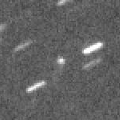
|
Now it is 16.9 mag (Oct. 29, Toshihiko Ikemura, Hirohisa Sato). It will brighten up to 16 mag in 2022. In the Northern Hemisphere, it stays observable in good condition for a long time. In the Southern Hemisphere, it is not observable until 2023.
Date(TT) R.A. (2000) Decl. Delta r Elong. m1 Best Time(A, h)
Nov. 6 9 34.99 65 46.4 3.772 4.053 99 16.5 4:59 (198, 56)
Nov. 13 9 44.29 68 15.5 3.681 4.031 103 16.4 5:05 (192, 55)
|
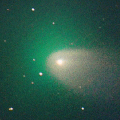
|
It brightened up to 9.7 mag in June (June 4, Michael Jager). Now it is fading. It has already faded down to 16.3 mag (Oct. 12, ATLAS-MLO, Mauna Loa). In the Southern Hemisphere, it stays observable in excellent condition for a long time. In the Northern Hemisphere, it becomes extremely low after this.
Date(TT) R.A. (2000) Decl. Delta r Elong. m1 Best Time(A, h)
Nov. 6 23 22.88 -37 10.0 1.651 2.184 108 16.4 20:20 ( 0, 18)
Nov. 13 23 27.41 -35 4.5 1.769 2.238 104 16.8 19:57 ( 0, 20)
|

|
Now it is 17.0 mag (Nov. 1, Toshihiko Ikemura, Hirohisa Sato). It will brighten rapidly, and it will be observable at 13.5 mag in good condition from winter to spring.
Date(TT) R.A. (2000) Decl. Delta r Elong. m1 Best Time(A, h)
Nov. 6 9 31.58 18 32.7 2.680 2.763 84 16.7 4:59 (303, 64)
Nov. 13 9 39.14 18 3.6 2.563 2.738 89 16.5 5:05 (315, 68)
|
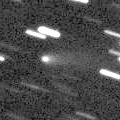
|
It brightened up to 15.2 mag in summer (Aug. 25, Ken-ichi Kadota). Now it is fading. It has already faded down to 17.0 mag (Nov. 4, Toshihiko Ikemura, Hirohisa Sato). It will be fainter than 18 mag in December. In the Northern Hemisphere, it stays observable in good condition for a long time. It locates extremely low in the Southern Hemisphere.
Date(TT) R.A. (2000) Decl. Delta r Elong. m1 Best Time(A, h)
Nov. 6 8 44.08 36 16.1 1.279 1.741 99 16.5 4:59 (259, 81)
Nov. 13 8 56.06 37 38.3 1.255 1.775 103 16.7 5:05 (240, 85)
|
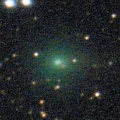
|
It brightened very rapidly up to 10.7 mag in July (July 20, Osamu Miyazaki). Now it is fading. It has already faded down to 17.3 mag (Nov. 4, Toshihiko Ikemura, Hirohisa Sato). It stays observable in the morning sky for a long time.
Date(TT) R.A. (2000) Decl. Delta r Elong. m1 Best Time(A, h)
Nov. 6 8 58.58 25 54.3 1.458 1.816 93 16.6 4:59 (302, 74)
Nov. 13 9 2.66 26 6.8 1.440 1.882 99 16.7 5:05 (322, 79)
|
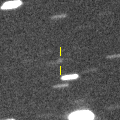
|
Now it is 17.3 mag (Oct. 2, Toshihiko Ikemura, Hirohisa Sato). It will brighten up to 15.5 mag, and will be observable in excellent condition in winter.
Date(TT) R.A. (2000) Decl. Delta r Elong. m1 Best Time(A, h)
Nov. 6 10 10.53 11 38.1 2.060 2.009 73 16.7 4:59 (300, 52)
Nov. 13 10 23.84 10 45.4 1.992 2.011 76 16.6 5:05 (307, 55)
|
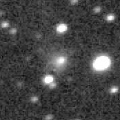
|
Now it is 16.3 mag (Oct. 26, ATLAS-MLO, Mauna Loa). It is observable at 16 mag from 2020 to 2021. It locates low in the Southern Hemisphere.
Date(TT) R.A. (2000) Decl. Delta r Elong. m1 Best Time(A, h)
Nov. 6 21 31.57 27 15.0 5.826 6.197 107 16.6 18:29 ( 0, 82)
Nov. 13 21 30.92 25 49.3 5.934 6.211 101 16.7 18:23 ( 29, 80)
|
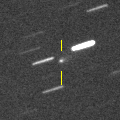
|
Now it is 16.9 mag (Nov. 4, Toshihiko Ikemura, Hirohisa Sato). It stays observable at 17 mag from autumn to winter. In the Northern Hemisphere, it stays observable in good condition. In the Southern Hemisphere, it stays extremely low until November.
Date(TT) R.A. (2000) Decl. Delta r Elong. m1 Best Time(A, h)
Nov. 6 10 59.34 10 26.4 2.050 1.802 61 16.7 4:59 (290, 42)
Nov. 13 11 13.69 8 30.3 2.005 1.815 64 16.7 5:05 (296, 45)
|
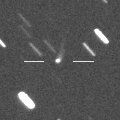
|
It was expected to brighten up to 14.5 mag from spring to summer. But actually, it is fainter than expected. Now it is 16.4 mag (Oct. 4, ATLAS-MLO, Mauna Loa). In the Southern Hemisphere, it stays observable for a long time. In the Northern Hemisphere, it is not observable after this.
Date(TT) R.A. (2000) Decl. Delta r Elong. m1 Best Time(A, h)
Nov. 6 11 52.48 -51 52.2 3.902 3.343 49 16.7 4:59 (328,-11)
Nov. 13 11 56.23 -52 8.2 3.916 3.386 51 16.8 5:05 (331, -8)
|
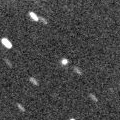
|
Now it is 16.9 mag (Oct. 22, J.-G. Bosch, F. Kugel). It is expected to brighten up to 4.5 mag in 2022 April. However, it is not observable at the high light. In the Northern Hemisphere, it stays observable until early February when it brightens up to 14 mag. Then it will appear at 6 mag in mid May, and it stays observable in good condition after that while the comet will be fading. In the Southern Hemisphere, it stays observable until December when it brightens up to 16 mag. But after that, it is not observable until 2022 August.
Date(TT) R.A. (2000) Decl. Delta r Elong. m1 Best Time(A, h)
Nov. 6 21 57.44 13 31.5 2.565 3.063 110 16.9 18:54 ( 0, 69)
Nov. 13 21 55.60 11 48.0 2.575 2.970 103 16.8 18:25 ( 0, 67)
|

|
Now it is 17.0 mag (Oct. 18, ATLAS-HKO, Haleakala). It brightened rapidly. It stays 17 mag for a long time from 2021 to 2022. In the Southern Hemisphere, it stays observable in good condition for a long time. In the Northern Hemisphere, it will be observable only in extremely low sky from autumn to winter.
Date(TT) R.A. (2000) Decl. Delta r Elong. m1 Best Time(A, h)
Nov. 6 9 8.23 -31 37.0 5.472 5.332 76 16.9 4:59 (344, 21)
Nov. 13 9 6.66 -33 18.0 5.389 5.332 81 16.8 5:05 (352, 21)
|

|
It brightened up to 11.6 mag in winter (Feb. 18, Thomas Lehmann). Now it is fading. It has already faded down to 17.6 mag (Oct. 18, J. Drummond). In the Southern Hemisphere, it stays observable in good condition after this. In the Northern Hemisphere, it will never be observable after this.
Date(TT) R.A. (2000) Decl. Delta r Elong. m1 Best Time(A, h)
Nov. 6 2 21.87 -69 13.8 4.091 4.289 94 16.8 23:16 ( 0,-14)
Nov. 13 2 2.08 -68 6.6 4.187 4.353 93 16.9 22:29 ( 0,-13)
|

|
Now it is 16.3 mag (Oct. 29, Toshihiko Ikemura, Hirohisa Sato). It stays at 16-17 mag from 2020 to 2021. In the Northern Hemisphere, it stays observable in good condition for a long time. In the Southern Hemisphere, it is not observable after this.
Date(TT) R.A. (2000) Decl. Delta r Elong. m1 Best Time(A, h)
Nov. 6 18 23.79 47 25.2 9.049 8.931 80 16.9 18:27 (124, 53)
Nov. 13 18 25.98 47 13.2 9.087 8.938 78 16.9 18:23 (124, 50)
|
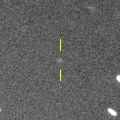
|
Now it is 16.3 mag (Oct. 29, Toshihiko Ikemura, Hirohisa Sato). It continues brightening even after the perihelion passage. It stays observable at 17 mag in good condition for a while.
Date(TT) R.A. (2000) Decl. Delta r Elong. m1 Best Time(A, h)
Nov. 6 5 4.07 -16 4.1 3.021 3.767 132 16.9 2:04 ( 0, 39)
Nov. 13 5 0.14 -16 21.4 3.003 3.785 136 16.9 1:33 ( 0, 39)
|
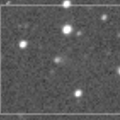
|
First return of a new periodic comet which brightened up to 17 mag in 2006. Now it is 17.4 mag (Sept. 27, N. Paul, E. Cortes). It stays 17 mag from 2021 to 2022. In the Southern Hemisphere, it stays observable in good condition for a while. It locates extremely low in the Northern Hemisphere.
Date(TT) R.A. (2000) Decl. Delta r Elong. m1 Best Time(A, h)
Nov. 6 21 46.10 -54 10.0 3.053 3.142 85 16.9 18:44 ( 0, 1)
Nov. 13 21 52.70 -52 8.0 3.116 3.135 81 16.9 18:23 ( 0, 3)
|

|
Now it is 17.4 mag (Nov. 4, Toshihiko Ikemura, Hirohisa Sato). It stays 17-18 mag for a long time from 2021 to 2022. It is observable in excellent condition in the Northern Hemisphere, It locates somewhat low in the Southern Hemisphere.
Date(TT) R.A. (2000) Decl. Delta r Elong. m1 Best Time(A, h)
Nov. 6 4 40.92 34 31.5 4.608 5.473 147 17.1 1:42 ( 0, 90)
Nov. 13 4 29.85 34 28.0 4.543 5.462 156 17.0 1:03 ( 0, 90)
|
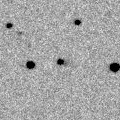
|
Now it is 15.5 mag (Nov. 2, Toshihiko Ikemura, Hirohisa Sato). It is observable at 16-17 mag in good condition in autumn. It is brighter than this ephemeris recently.
Date(TT) R.A. (2000) Decl. Delta r Elong. m1 Best Time(A, h)
Nov. 6 2 13.46 14 39.1 2.812 3.798 172 17.0 23:10 ( 0, 70)
Nov. 13 2 10.29 14 0.5 2.834 3.797 164 17.1 22:39 ( 0, 69)
|
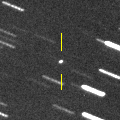
|
Now it is 17.0 mag (Oct. 29, Toshihiko Ikemura, Hirohisa Sato). In the Northern Hemisphere, it stays observable in good condition after this while the comet will be fading. In the Southern Hemisphere, it stays locating extremely low for a long time.
Date(TT) R.A. (2000) Decl. Delta r Elong. m1 Best Time(A, h)
Nov. 6 5 14.18 42 40.5 2.220 3.032 138 17.1 2:15 (180, 82)
Nov. 13 5 7.35 42 56.8 2.224 3.088 145 17.1 1:41 (180, 82)
|
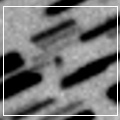
|
Now it is 17.3 mag (Oct. 29, Toshihiko Ikemura, Hirohisa Sato). It is expected to brighten up to 11 mag in 2022 summer. In the Northern Hemisphere, it stays observable in good condition until 2022 June when it brightens up to 11 mag. But it is not observable after the high light. In the Souther Hemisphere, it is not observable until 2022 October.
Date(TT) R.A. (2000) Decl. Delta r Elong. m1 Best Time(A, h)
Nov. 6 22 54.73 61 11.7 3.177 3.763 119 17.3 19:51 (180, 64)
Nov. 13 22 45.65 60 8.5 3.133 3.689 116 17.1 19:15 (180, 65)
|

|
First return of a new periodic comet which brightened up to 17 mag in 2011. Now it is 16.8 mag (Oct. 10, Ken-ichi Kadota). It stays observable at 17 mag in good condition until 2022 spring.
Date(TT) R.A. (2000) Decl. Delta r Elong. m1 Best Time(A, h)
Nov. 6 11 11.91 9 12.2 1.853 1.575 58 17.3 4:59 (289, 39)
Nov. 13 11 31.29 7 17.7 1.804 1.566 60 17.2 5:05 (294, 41)
|

|
Now it is 18.7 mag (Oct. 14, Catalina Sky Survey). In the Northern Hemisphere, it stays observable at 17 mag in good condition from November to December. It locates low in the Southern Hemisphere.
Date(TT) R.A. (2000) Decl. Delta r Elong. m1 Best Time(A, h)
Nov. 6 3 55.93 40 3.4 1.364 2.284 151 17.5 0:57 (180, 85)
Nov. 13 3 36.48 39 20.9 1.311 2.259 157 17.3 0:11 (180, 86)
|

|
Now it is 16.5 mag (Sept. 3, Thomas Lehmann). In the Northern Hemisphere, it stays observable for a long time while it is getting fainter slowly. In the Southern Hemisphere, it will never be observable again.
Date(TT) R.A. (2000) Decl. Delta r Elong. m1 Best Time(A, h)
Nov. 6 14 23.79 41 28.7 7.559 7.077 57 17.3 4:59 (232, 18)
Nov. 13 14 27.91 41 10.0 7.569 7.125 59 17.3 5:05 (235, 23)
|
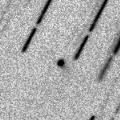
|
Michael Jager detected its cometary activity on Sept. 25. It approached to Earth down to 0.35 a.u. in early October, and it brightened up to 16.2 mag (Oct. 3, Michael Jager). Now it is fading rapidly. It has already faded down to 18.0 mag (Oct. 27, Katsumi Yoshimoto).
Date(TT) R.A. (2000) Decl. Delta r Elong. m1 Best Time(A, h)
Nov. 6 1 2.51 -12 54.9 0.475 1.396 141 17.3 22:00 ( 0, 42)
Nov. 13 1 15.15 -14 33.3 0.525 1.417 136 17.6 21:45 ( 0, 40)
|

|
Now it is 18.7 mag (Nov. 3, Toshihiko Ikemura, Hirohisa Sato). It will brighten up to 16.5-17 mag in winter. In its last apparition in 2015, it brightened up to 13 mag.
Date(TT) R.A. (2000) Decl. Delta r Elong. m1 Best Time(A, h)
Nov. 6 21 56.33 -30 46.2 1.661 2.030 96 17.4 18:54 ( 0, 24)
Nov. 13 22 3.37 -29 47.5 1.699 1.991 91 17.3 18:34 ( 0, 25)
|
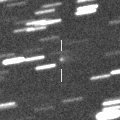
|
Now it is 17.5 mag (Nov. 5, Toshihiko Ikemura, Hirohisa Sato). In the Northern Hemisphere, it stays observable at 17 mag in good condition until winter. In the Southern Hemisphere, it stays locating extremely low for a while.
Date(TT) R.A. (2000) Decl. Delta r Elong. m1 Best Time(A, h)
Nov. 6 9 4.96 26 44.2 1.869 2.155 92 17.4 4:59 (296, 74)
Nov. 13 9 11.15 25 39.2 1.817 2.185 97 17.4 5:05 (316, 77)
|
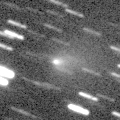
|
Outburst occured in early August, and it brightened up to 14.1 mag (Aug. 7, Michael Jager). Now it is fading. It has already faded down to 17.5 mag (Nov. 3, Toshihiko Ikemura, Hirohisa Sato). In the Northern Hemisphere, it stays observable in good condition. In the Southern Hemipsphere, it stays locating extremely low after this.
Date(TT) R.A. (2000) Decl. Delta r Elong. m1 Best Time(A, h)
Nov. 6 5 56.30 48 31.5 2.067 2.801 129 17.4 2:57 (180, 76)
Nov. 13 5 51.52 48 57.3 2.039 2.830 135 17.7 2:25 (180, 76)
|
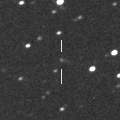
|
Now it is 17.2 mag (Nov. 2, Toshihiko Ikemura, Hirohisa Sato). It will brighten up to 14 mag in early 2023. It stays observable in good condition for a long time until spring.
Date(TT) R.A. (2000) Decl. Delta r Elong. m1 Best Time(A, h)
Nov. 6 4 49.76 2 39.8 4.459 5.313 146 17.5 1:50 ( 0, 58)
Nov. 13 4 47.15 2 31.4 4.373 5.269 152 17.4 1:20 ( 0, 58)
|
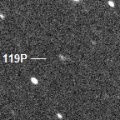
|
Now it is 17.4 mag (Nov. 3, Toshihiko Ikemura, Hirohisa Sato). It will brighten up to 15 mag in 2022 winter. In 2021, it stays observable in good condition while the comet will be brightening gradually.
Date(TT) R.A. (2000) Decl. Delta r Elong. m1 Best Time(A, h)
Nov. 6 22 24.39 -18 29.2 2.513 2.965 107 17.5 19:22 ( 0, 37)
Nov. 13 22 26.93 -18 2.3 2.582 2.939 101 17.5 18:57 ( 0, 37)
|
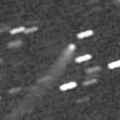
|
Now it is 17.4 mag (Oct. 29, Toshihiko Ikemura, Hirohisa Sato). Fading slowly. In the Northern Hemisphere, it stays observable in good condition for a long time. It is not observable after this in the Southern Hemisphere.
Date(TT) R.A. (2000) Decl. Delta r Elong. m1 Best Time(A, h)
Nov. 6 16 25.94 47 42.6 6.314 6.006 67 17.5 18:27 (128, 34)
Nov. 13 16 29.36 47 37.1 6.346 6.041 67 17.6 18:23 (129, 31)
|

|
Now it is 21.4 mag (Aug. 19, Pan-STARRS 1, Haleakala). It was expected to be observable at 17 mag from November to March. But actually, it is much fainter than expected. It is observable in good condition in the Northern Hemisphere, but it locates low in the Southern Hemisphere.
Date(TT) R.A. (2000) Decl. Delta r Elong. m1 Best Time(A, h)
Nov. 6 6 6.85 21 11.0 1.922 2.687 131 17.7 3:07 ( 0, 76)
Nov. 13 6 6.31 21 48.8 1.840 2.668 139 17.6 2:39 ( 0, 77)
|

|
It will brighten up to 11.5 mag in 2022 winter. Now it is 18.8 mag (Oct. 16, Purple Mountain Observatory, XuYi Station). It stays observable while the comet will be brightening slowly.
Date(TT) R.A. (2000) Decl. Delta r Elong. m1 Best Time(A, h)
Nov. 6 3 40.84 15 3.1 2.576 3.547 166 18.0 0:41 ( 0, 70)
Nov. 13 3 34.95 14 40.8 2.528 3.513 173 17.9 0:08 ( 0, 70)
|

|
Now it is 18.3 mag (Nov. 3, Toshihiko Ikemura, Hirohisa Sato). It is observable at 17-18 mag in good condition from November to December.
Date(TT) R.A. (2000) Decl. Delta r Elong. m1 Best Time(A, h)
Nov. 6 6 11.22 -6 54.1 1.150 1.892 123 18.1 3:11 ( 0, 48)
Nov. 13 5 57.87 -3 26.9 1.070 1.896 133 17.9 2:31 ( 0, 51)
|
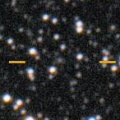
|
Now it is 17.4 mag (Oct. 2, Toshihiko Ikemura, Hirohisa Sato). It stays observable at 17-18 mag for a long time from 2021 to 2022.
Date(TT) R.A. (2000) Decl. Delta r Elong. m1 Best Time(A, h)
Nov. 6 19 35.71 -18 30.9 4.320 4.075 69 17.9 18:27 ( 31, 30)
Nov. 13 19 42.19 -18 19.0 4.413 4.073 63 18.0 18:23 ( 36, 28)
|
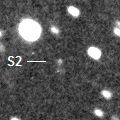
|
First return of a new periodic comet which brightened up to 17 mag in 2012. Now it is 18.4 mag (Oct. 26, Catalina Sky Survey). It is observable in excellent condition in the Southern Hemisphere. It locates low in the Northern Hemisphere.
Date(TT) R.A. (2000) Decl. Delta r Elong. m1 Best Time(A, h)
Nov. 6 21 51.85 -23 41.8 0.803 1.364 98 17.9 18:50 ( 0, 32)
Nov. 13 22 13.26 -20 22.4 0.831 1.371 97 18.0 18:44 ( 0, 35)
|
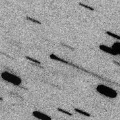
|
Now it is 18.1 mag (Oct. 3, Michael Jager). Main-belt asteroid, but it has a long tail of 10 arcmin. It stays observable in good condition until winter.
Date(TT) R.A. (2000) Decl. Delta r Elong. m1 Best Time(A, h)
Nov. 6 23 34.07 -2 49.8 1.794 2.541 129 20.2 20:31 ( 0, 52)
Nov. 13 23 35.25 -2 42.3 1.879 2.554 122 20.4 20:05 ( 0, 52)
|
|
![]()
 106P/Schuster
106P/Schuster 15P/Finlay
15P/Finlay 70P/Kojima
70P/Kojima C/2019 T3 ( ATLAS )
C/2019 T3 ( ATLAS ) 52P/Harrington-Abell
52P/Harrington-Abell C/2019 T2 ( Lemmon )
C/2019 T2 ( Lemmon ) C/2021 O3 ( PanSTARRS )
C/2021 O3 ( PanSTARRS ) C/2020 F7 ( Lemmon )
C/2020 F7 ( Lemmon ) C/2019 N1 ( ATLAS )
C/2019 N1 ( ATLAS ) C/2019 O3 ( Palomar )
C/2019 O3 ( Palomar ) 254P/McNaught
254P/McNaught 422P/2021 L1 ( Christensen )
422P/2021 L1 ( Christensen ) C/2020 U4 ( PanSTARRS )
C/2020 U4 ( PanSTARRS ) P/2021 N2 ( Fuls )
P/2021 N2 ( Fuls ) 28P/Neujmin 1
28P/Neujmin 1 C/2021 P4 ( ATLAS )
C/2021 P4 ( ATLAS ) 430P/2021 Q2 ( Scotti )
430P/2021 Q2 ( Scotti ) (3200) Phaethon
(3200) Phaethon C/2018 N2 ( ASASSN )
C/2018 N2 ( ASASSN ) 2010 OE101
2010 OE101 230P/LINEAR
230P/LINEAR 241P/LINEAR
241P/LINEAR 17P/Holmes
17P/Holmes C/2020 S4 ( PanSTARRS )
C/2020 S4 ( PanSTARRS ) 119P/Parker-Hartley
119P/Parker-Hartley C/2019 K7 ( Smith )
C/2019 K7 ( Smith ) 274P/Tombaugh-Tenagra
274P/Tombaugh-Tenagra 81P/Wild 2
81P/Wild 2 P/2021 U3 ( Attard-Maury )
P/2021 U3 ( Attard-Maury ) 395P/2020 H1 ( Catalina-NEAT )
395P/2020 H1 ( Catalina-NEAT ) 424P/2021 L5 ( La Sagra )
424P/2021 L5 ( La Sagra ) 433P/(248370) 2005 QN173
433P/(248370) 2005 QN173![]()




































































